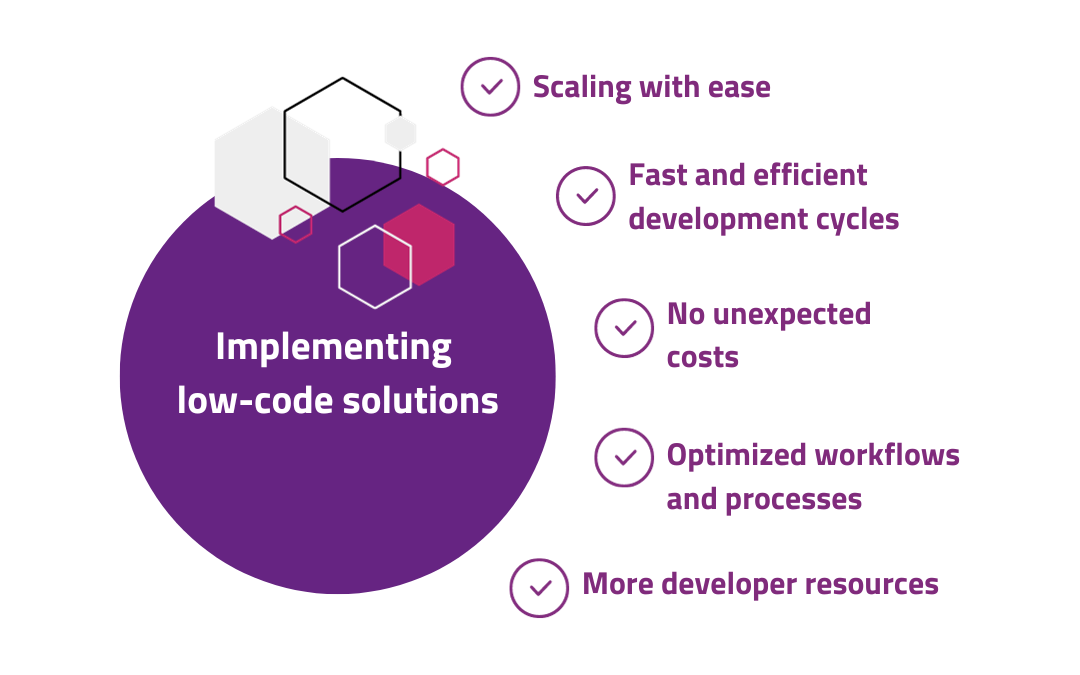The past few years’ events have driven the world into a state of economic uncertainty, impacting many organizations across the globe. These businesses are finding themselves confronted with serious financial constraints, forcing them to undertake a comprehensive reassessment of their IT budgets. This often entails making tough choices, including the painful decision of implementing mass layoffs or halting IT tool subscriptions. In response to these challenges, many organizations are turning to low-code workflow platforms to streamline their operations and reduce costs.
Our latest eBook, Future-proof your business with low-code software solutions in 2024, was designed with a dual purpose in mind. Firstly, we discuss effective cost-saving strategies tailored to organizations navigating these uncertain times. Secondly, we offer a practical guide for digitalization, equipping teams with the necessary knowledge to develop customized, in-house solutions for optimizing their workflows.
At the core of these insights and best practices lies what we consider is a must-have for enterprises to rapidly increase productivity and efficiency: low-code workflow platforms.
Click here to download the eBook.
Now, let’s explore why low-code software solutions can be a game-changer for your organization.
Overcoming today’s challenges with low-code solutions
Economic uncertainty means a series of challenges for many organizations, especially for those in survival or adaptive mode. These challenges include coping with inflation, managing escalating labor costs, stagnant or declining revenues, and often, a mounting application backlog, largely stemming from inefficient processes and the shortage of developers and technical specialists.
Technology leaders tasked to solve these issues do not have it easy: they have to first gain a comprehensive understanding of their companies’ global tech stack, pinpoint inefficiencies, and develop effective strategies for modernizing processes, without increasing the need for resources.
What elevates low-code workflow platforms from nice-to-have to an essential asset is its ability to empower IT departments to quickly develop solutions for their specific needs, all while keeping costs in check. To bridge the gap caused by a shortage of developers and traditional development timelines, low-code workflow platforms offer organizations the ability to expedite time-to-value by enhancing existing legacy core capabilities, simplifying migration projects, and substituting legacy applications with low-code solutions.
Turning to low-code workflow platforms: Preparing your company for tomorrow’s challenges
Improving current workflows is a fundamental step in rapidly boosting productivity. However, IT leaders must also maintain a vigilant focus on ongoing efforts to prepare the company for future challenges, especially during such uncertain times.
Their top priority must revolve around digitally equipping the company, enabling it to swiftly adapt to evolving markets and customer needs. The great thing about low-code development is that it not only improves current processes but also presents a cost-effective avenue to prepare for not-yet-known challenges you’ll likely face in a rapidly evolving market.
Here’s how implementing low-code solutions today will prove valuable in the long run:
1. You’ll scale with ease, without needing new technology
The modular design of low-code business workflow solutions helps break down complex systems into smaller, manageable components. The benefits of a modular IT landscape include reduced development time, enabling faster solutions to meet evolving industry trends, and the flexibility for creating new modules without having to start from scratch. And the cherry on top: since low-code platforms are constantly updated, you will not need to worry about changing your tech stack again, for a very, very long time.
2. Your development cycles will be fast and efficient
Low-code software offers a quicker development cycle, thanks to its user-friendly drag-and-drop approach, in contrast to the time-consuming line-by-line coding of conventional software development. The sped-up process optimization is facilitated by the accessibility and tools that empower teams to independently modify and automate workflows, enhancing collaboration, and enabling swift responses to customer feedback and competitor dynamics.
3. You don’t have to worry about unexpected costs
In the current economic landscape, any opportunity to reduce costs is a significant advantage. Low-code software requires less coding skills, therefore, it significantly reduces development costs by eliminating the need for highly skilled developers and accelerates the entire coding process. Moreover, it boosts efficiency through automation and eliminates many, previously time-consuming and non-scalable processes.
4. You’ll optimize your workflows and processes
Low-code software facilitates process optimization by offering accessible tools for rapid and incremental development. This autonomy empowers teams to quickly update workflows, without relying on the tech department. Furthermore, low code streamlines processes, fosters standardization, and reduces inconsistencies. With seamless organization, digitalization, and integration of processes, low-code elevates workflow management capabilities, enhancing visibility and control.
5. Your teams will thank you
Low-code platforms break down the barriers that complicate and slow down the operation experienced in systems with overly complex functionality, promoting collaboration across all company levels and departments. As a result, low code not only relieves IT burdens but also frees up developer resources so they can focus on important tasks like advancing digital innovation.

Low-code workflow platforms for a seamless journey to a digitalized future
The changing economic landscape of recent years has presented significant challenges to organizations worldwide, making the ability to adapt quickly a priority. When it comes to the tech stack, businesses cannot afford to remain in the past any longer — and that’s precisely where low-code platforms come into play: to pave the way for a seamless journey into the future.
Would you like to learn more about implementing low-code solutions into your business processes? Feel free to get in touch with our team — we are always happy to help!



